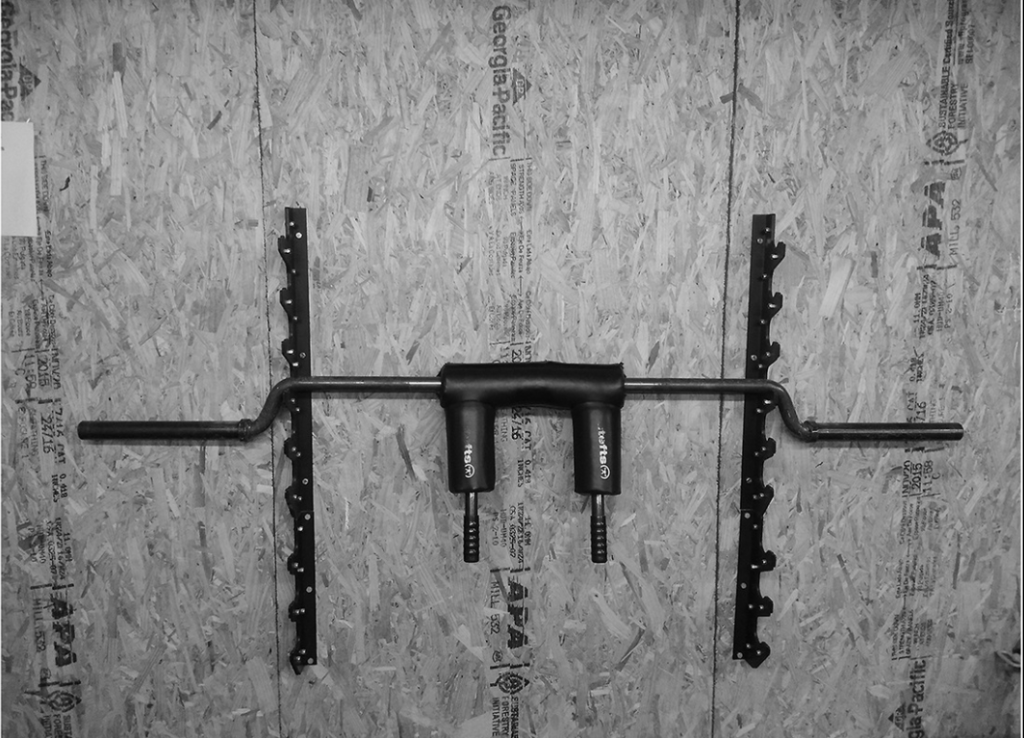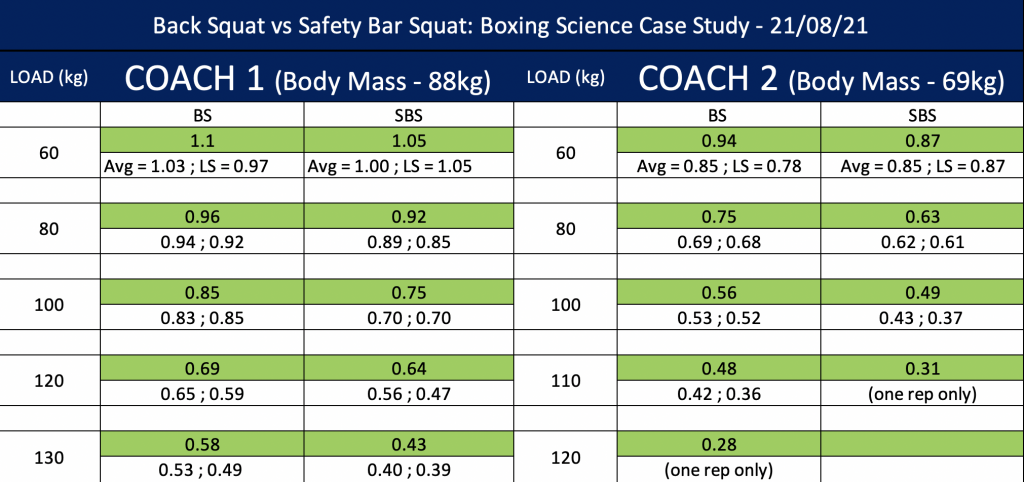Safety Bar Squat vs Back Squat
The squat pattern is often considered the centrepiece of strength training for many sports.
Typically, the squat is programmed with the intention of increasing lower body force production (strength) and, indirectly, rate of force development which are both influential physical metrics for explosive movements such as sprinting, jumping and changing direction (1, 2).
Using the squat for this purpose has proven effective in the existing literature with increased sprint (4), jump (3) and agility (5) performance being displayed following both long and short term bouts of strength training with emphasis on the squat pattern.
Though much of the research has been conducted in team sport settings, the squat pattern has also gained popularity among some of the most high profile names in Boxing, including, Canelo Alvarez, Anthony Joshua and Josh Taylor.
At Boxing Science, squat variations have always featured in our programs for a number of reasons which are outlined here: https://boxingscience.co.uk/squats-for-boxing/
Despite the importance of the squat, the traditional method of performing the lift i.e bar positioned on the upper traps and squatting to below parallel, may not be the most optimal exercise for every athlete due to a lack of strength training exposure, long limb lengths, muscle imbalances and previous injuries.
This mindset has given rise to innovative means of adjusting the lift and increase suitability for specific athletes.
One such innovation is the Safety Squat bar.
SAFETY BAR SQUATTING

As can be seen in the image, the safety squat bar is an adjusted bar that that enables the lifter to hold the bar in a more neutral position compared to the traditional back squat.
Instead of athletes externally rotating their shoulders and elbows to maintain a firm grip on the bar during a traditional back squat, the safety bar handles can be held with hands in front of the torso, thus reducing the shoulder mobility demands of the lift.
This altered bar design has also been shown to contribute to less trunk flexion (forward lean) during the eccentric phase of a squat, potentially decreasing stress on the lower back in comparison to squatting with a conventional bar (6).
Less trunk flexion during this squatting variation is likely due to the weight being shifted to a more anterior position, almost representing a mid point between load distribution during a conventional back squat and a front squat.
In the same investigation, the authors also reported increased lower trapezius/upper back activation during the safety bar squat compared to a standard barbell.
In terms of lower body muscle activation, the conventional back squat elicited greater hamstring, lateral hamstring, quadricep and rectus abdominis activity (6), however, the authors attributed this to the significant discrepancy in relative loads used between loads.
In other words, participants had a higher 3RM for the traditional back squat compared to the safety bar variation.
Thus, higher loads will produce greater muscle activation values, irrespective of the technique.
Despite significant differences in loading capabilities, Kristiansen et al. (7) still reported higher gluteus maximus activity during a safety bar squat compared to both high and low straight bar squatting techniques among recreationally trained men and women.
Such heightened activity of the gluteus maximus may be explained by the maintenance of a more upright trunk angle when using the safety bar apparatus (7)
A more vertical trunk angle diminishes the input of the lower back, and creates joint angles around the hip and knee which enable the glutes to maximise their force-length properties when driving out of the bottom position.
Whilst these two publications have provided much needed insight into the muscle activation and joint moment trends associated with the safety bar squat, barbell velocity in comparison to the traditional squat is also worth consideration, particularly for strength and conditioning professions aiming to improve accelerative capabilities of the lower body.
Recent work by Vantrease and colleagues (8), sought to determine barbell velocities when using the safety bar and compared them against those observed with a straight bar.
The authors initially tested each participant for their one repetition maximum using each barbell, on two separate testing days.
For the experimental procedure, participants were then required to perform three repetitions at 65% and 85% of their 1RM for both variations.
Muscle activity and barbell velocity were recorded and compared for each lift.
Similar to previous publications referenced above, one repetition maximum loads were significantly higher (10.9% higher) for the traditional back squat compared to the safety bar set up.
Consequently, the relative intensities used during the experimental protocol i.e 65 and 85% 1RM, were also significantly greater when using the straight bar.
At the same relative intensities, the authors reported similar barbell velocities as shown in the image below:

At surface level these findings may present the safety bar squat as somewhat equal to the traditional back squat.
Though velocities were similar between conditions, the fact that 65 and 85% 1RM were at much higher absolute loads during the back squat ultimately highlight the greater force velocity characteristics associated with the conventional lift compared to its variations.
Therefore, if power is a by product of Force x Velocity it is logical to assume that the back squat elicits higher power outputs and rate of force development in comparison to the the safety bar back squat due to the greater force required to lift heavier loads.
As a result, the stimulus imposed on the neuromuscular system using each lift is likely to differ drastically.
With anything in strength and conditioning it is never a case of one is better than the other but rather what is best for the given training goal or context.
The main limitation of the existing research is that relative rather than absolute loads have been used when comparing the traditional and safety bar back squat.
This ultimately compromises the validity of the comparison particularly around muscle activation as higher loads will tend to yield greater levels of muscle activity regardless of technique.
Therefore, it is hard to solely attribute differences in muscle recruitment to the shape of the bar and subsequent position of the load.
As a means of addressing this ambiguity for the benefits of our own programming we conducted a mini experiment among two of our coaches at Boxing Science.
BOXING SCIENCE CASE STUDY
This brief experiment involved two of our coaches performing sets back to back of both squat variations at the same loads.
Repetitions for each squat variation were performed at 60kg, 80kg, 100kg, 120kg and 130kg.
Mean Bar speed was measured during each rep using a GymAware Power Tool and associated application.
Immediate feedback on bar speed was provided for each rep to encourage maximal intent throughout the set.
2-3 minutes rest was allocated between sets of either lift to manage fatigue accumulation.
Whilst not a rigidly controlled experiment we did manage to observe some interesting trends…
RESULTS
The main finding from this impromptu investigation was that the back squat produced higher average velocities across each load compared to the safety bar.

Additionally, the differences in speed become even more apparent when lifting heavier loads
As can be seen in the case of Coach 2, there were noticeable decrements in strength when using the safety bar compared to the conventional bar with only one rep being performed at 110kg and a failed rep at 120kg performing this variation.
Average (Avg) and the last score of each set (LS) were recorded to determine speed maintenance across each set for both lifts.
Lastly, from Coach one’s results, we can see that at higher loads (≥100kg) the % drop off was 4.2% greater when the safety bar squatting compared to back squatting.
This is likely to have implications for strength speed phases where the aim is to move relatively heavy loads as rapidly as possible.
CONCLUSIONS
Using the results from this experiment and combining them with insights provided by the publications referenced above there are some important takeaways regarding the implementation of both squat variations into a training program.
As always, it is important to keep in mind the desired training adaptation and choose the most effective tools to achieve this.
Practical Applications
Firstly, the safety bar squat is likely to be a more suitable variation for general adaptation phases where the emphasis is on muscle activation and enhancing tissue/tendon quality whilst controlling compensations through the lower back.
This is based on the findings of Kristiansen et al. (7) and Hecker et al. (6) which have reported increased glute activation and less trunk flexion, respectively, when performing safety bar squats compared to the conventional.
Conversely, when aiming to maximise gains in lower body force production and rate of force development the standard barbell back squat is probably the more effective variation due to the lifter’s ability to accelerate heavy loads faster compared to the safety bar squat as illustrated in our own in house research project and in the work of Vantrease et al. (8).
In cases where the risk of the back squat outweigh the benefits and the safety bar remains the only option for a given athlete in terms of overloading the lower body, methods to maximise acceleration such as accommodating resistance and reducing the range of motion with Anderson/box squats.
SUMMARY
The squat pattern is a fundamental component of many strength training programs to improve lower body force production and, subsequently, rate of force development, contributing to improvements in explosive athletic tasks.
The safety bar squat is a variation of the standard back squat that reduces demands on shoulder mobility, promotes a more upright posture during the downward phase of a back squat and increases gluteal activation.
Combining the results of our mini in-house case study and that of the existing literature, the safety bar squat is likely to be an appropriate exercise for general preparation phases whereas the back squat is seemingly the more effective variation for improving lower body rate of force development.
REFERENCES
- Seitz, L.B., Reyes, A., Tran, T.T., de Villarreal, E.S. and Haff, G.G., 2014. Increases in lower-body strength transfer positively to sprint performance: a systematic review with meta-analysis. Sports medicine, 44(12), pp.1693-1702.
- Ruddock, A. and Winter, E., 2015. Jumping depends on impulse not power. Journal of sports sciences, 34(6), pp.584-585.
- Adams, K., O’Shea, J.P., O’Shea, K.L. and Climstein, M., 1992. The effect of six weeks of squat, plyometric and squat-plyometric training on power production. Journal of applied sport science research, 6(1), pp.36-41.
- Styles, W.J., Matthews, M.J. and Comfort, P., 2016. Effects of strength training on squat and sprint performance in soccer players. The Journal of Strength & Conditioning Research, 30(6), pp.1534-1539.
- Keiner, M., Sander, A., Wirth, K. and Schmidtbleicher, D., 2014. Long-term strength training effects on change-of-direction sprint performance. The Journal of Strength & Conditioning Research, 28(1), pp.223-231.
- Hecker, K.A., Carlson, L.A. and Lawrence, M.A., 2019. Effects of the safety squat bar on trunk and lower-body mechanics during a back squat. The Journal of Strength & Conditioning Research, 33, pp.S45-S51.
- Kristiansen, E., Larsen, S., Haugen, M.E., Helms, E. and van den Tillaar, R., 2021. A Biomechanical Comparison of the Safety-Bar, High-Bar, and Low-Bar Squat around the Sticking Region among Recreationally Resistance-Trained Men and Women. International Journal of Environmental Research and Public Health, 18(16), p.8351.
- Vantrease, W.C., Townsend, J.R., Sapp, P.A., Henry, R.N. and Johnson, K.D., 2021. Maximal Strength, Muscle Activation, and Bar Velocity Comparisons Between Squatting With a Traditional or Safety Squat Bar. The Journal of Strength & Conditioning Research, 35, pp.S1-S5.
